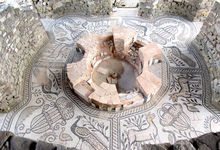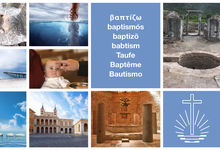The sacraments (9): The deadly word for baptism
Immersion is not necessarily the same as immersion. And baptism is not necessarily baptism. Sometimes even the smallest details can serve to hint at great innovations. Here is what can be discerned about the most fundamental of all the sacraments—just from looking at some spelling adaptations in key words of the Bible.

Baptism comes from diving—at least in the Greek. After all, baptisma derives from baptō. However, this verb is difficult to find, even in the New Testament. Instead, there is another term that prevails.
In Jesus’ time, it was a common practice for many Jews—for example the Essenes or the Qumran group—to take baths as a form of ritual purification. And soon the mikveh, which was a pool used for ritual immersion, became a familiar fixture in every respectable synagogue, even in mainstream Judaism.
The difference between these ablutions and the Christian baptism is precisely what the other word for “submersion” or “immersion” describes.
From submersion to drowning
Secular Greeks described the practices of the Jews using the term lono or baptō, meaning “to bathe” or “to dive”. By no means would they have written the word baptizō however. Although the latter term also meant “submersion” or “immersion”, it also had the connotation of sinking or drowning. And yet it was precisely this destructive term that came to be adopted in early Christendom.
The word baptō only appears four times in the New Testament, but the more deadly baptizō and its variant forms such as baptízein appear eighty times. It was quite similar with the noun for baptism: only five times does the New Testament use the term baptismós (which also means “washing”), but the modified version adapted to the Christian faith—namely baptisma—appears 22 times.
Why was this proximity between death and baptism so important to the Christian authors?
From the Baptist to Christ
We find our earliest hint with the term’s first appearance, namely in connection with a certain apocalyptic preacher from the desert who dressed in camel hair and dined on grasshoppers. In his preaching, John the Baptist called for radical change. His bath of immersion—in contrast to the others—was not repeated, but was instead a unique event. This is because it marked the end of one’s old life and the beginning of a new one.
Yet the Christian understanding of baptism is far more than that. A decisive reference is the manner in which Jesus Christ speaks of His imminent sacrificial death: “But I have a baptism to be baptised with, and how distressed I am till it is accomplished!” (Luke 12: 50). We find another such reference in the words: “Are you able to drink the cup that I drink, and be baptised with the baptism that I am baptised with?” (Mark 10,38)
This deadly baptism applies to every baptised individual to this very day.
From death to life
After all, human beings are baptised “into” or “in the name of” Jesus Christ. That is how it is formulated in the book of Acts. Paul explains the implications in Romans 6: “As we were baptised into Christ Jesus [we were also] baptised into His death.” And as closely as the baptised is connected with the death of Jesus, so he is also connected with the latter’s resurrection.
The relationship between death and baptism is the central notion around which the New Testament develops many other aspects of redemption. This will be the focus of a future issue in this series. But before that we will take a look at some very practical questions: did Jesus Himself ever baptise anyone? How did He institute this sacrament? And what form did He prescribe for this?
Article info
Author:
Date:
Keywords:
Andreas Rother
13.05.2020
sacraments,
Holy Baptism,
Doctrinal statements















